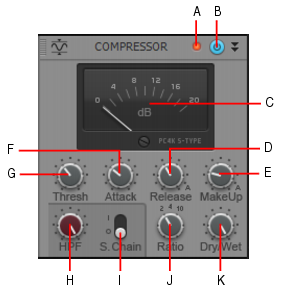Figure 296. PC4K S-Type Bus Compressor.A. Clipping LED B. Compressor enable/disable C. VU meter D. Release E. Make-up gain F. Attack G. Threshold H. Sidechain High Pass filter I. Sidechain enable/disable J. Ratio K. Dry/Wet levelThis is the default compressor module when using ProChannel on a bus. This module is based on the legendary center console stereo bus compressor in one of the world's most successful analog studio production mixing consoles. Known to add punch and drive to a mix. Also recommended for instruments like piano and drums. This mode supports sidechaining.















Tip - Searching Documentation
Tip: To search for a specific topic, type your search query in the Search Cakewalk.com field at the top right of this page.
When the search results appear, click which product's documentation you would like to search to filter the search results further.
Note - Using Offline Help
Note: If you prefer to always use offline Help, go to Edit > Preferences > File > Advanced in your Cakewalk software and select Always Use Offline Help.
If you are not connected to the internet, your Cakewalk software will default to showing offline help until an internet connection becomes available.




